练习收获
1
联想思考
有序,单调栈,双指针
2
C++中unordered_map和map的对比
unordered_map, 哈希表,无序,\(O(1)\),最差性能可能会退化成\(O(lgn)\)。适合查找场景。
map, 红黑树,有序,\(O(lgn)\), 存储空间大,适合有序场景。
同理unordered_set和set的对比。
练习题目
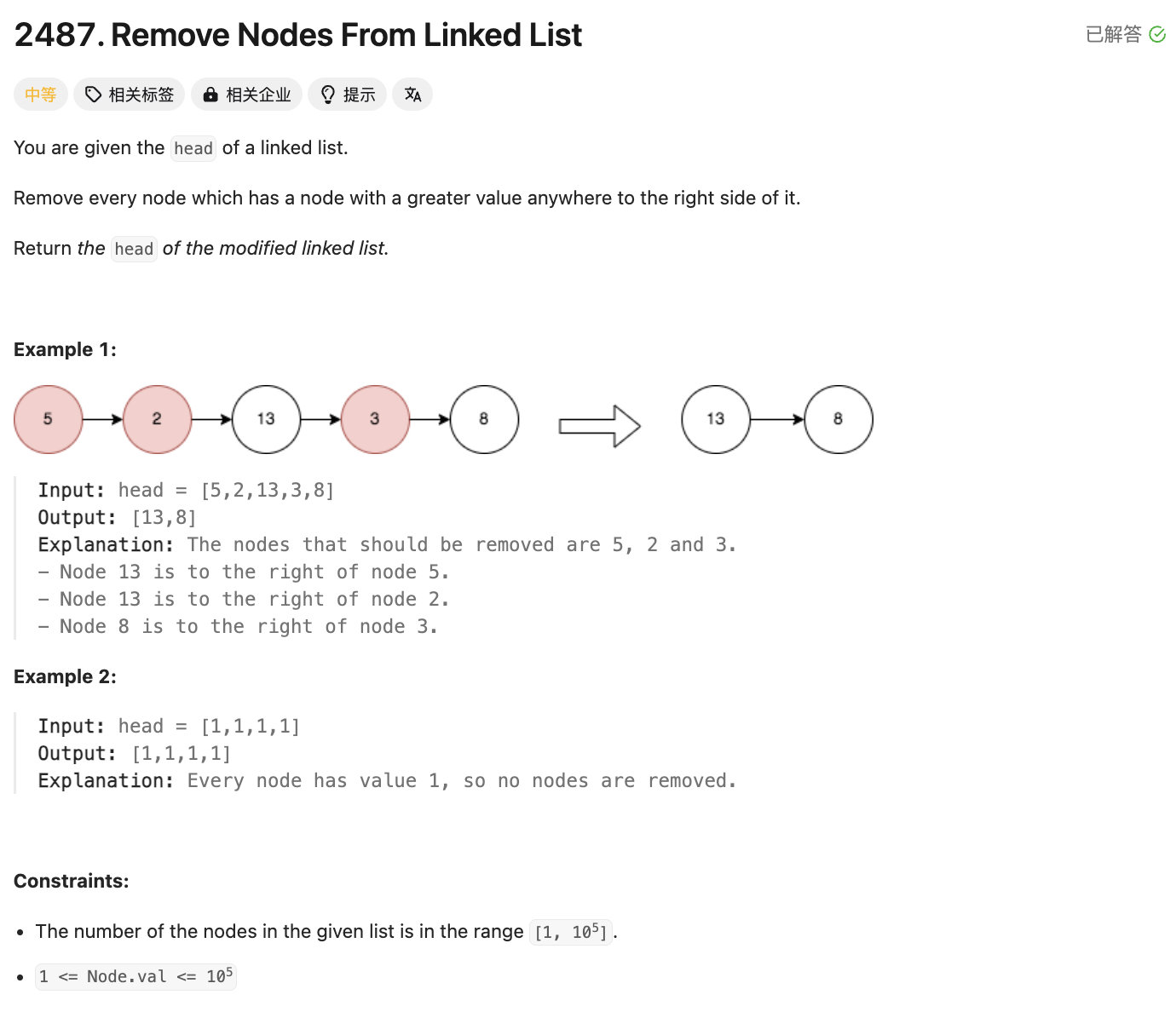
Version 1
递归程序实现,如果当前节点比递归回退出来的最大值还小,删除当前节点
1
2
3
4
5
6
7
8
9
10
11
12
13
14
15
16
17
18
19
20
| class Solution {
public:
int removeNodesWithVal(ListNode* head, ListNode* hsl) {
int max_val = 0;
if(head->next){
max_val = removeNodesWithVal(head->next, head);
}
if(head->val < max_val) {
hsl->next = head->next;
} else {
max_val = head->val;
}
return max_val;
}
ListNode* removeNodes(ListNode* head) {
ListNode* fhead = new ListNode(INT_MAX, head);
removeNodesWithVal(head, fhead);
return fhead->next;
}
};
|
Version 2
使用栈来代替递归
1
2
3
4
5
6
7
8
9
10
11
12
13
14
15
16
17
18
19
20
21
22
23
24
| class Solution {
public:
ListNode* removeNodes(ListNode* head) {
ListNode* fhead = new ListNode(INT_MAX, head);
stack<pair<ListNode*, ListNode*>> st;
while(head){
st.push(pair(head, fhead));
fhead = head;
head = head->next;
}
int max_right_val = fhead->val;
while(!st.empty()){
pair<ListNode*, ListNode*> ele = st.top();
st.pop();
if(ele.first->val < max_right_val) {
ele.second->next = ele.first->next;
} else {
max_right_val = ele.first->val;
}
fhead = ele.second;
}
return fhead->next;
}
};
|
Version 3
精简栈的使用
1
2
3
4
5
6
7
8
9
10
11
12
13
14
15
16
17
18
19
20
21
22
23
24
25
| class Solution {
public:
ListNode* removeNodes(ListNode* head) {
ListNode* fhead = new ListNode(INT_MAX, head);
stack<ListNode*> st;
while(head){
st.push(fhead);
fhead = head;
head = head->next;
}
int max_right_val = fhead->val;
while(!st.empty()){
ListNode* left = st.top();
ListNode* cur = left->next;
st.pop();
if(cur->val < max_right_val) {
left->next = cur->next;
} else {
max_right_val = cur->val;
}
fhead = left;
}
return fhead->next;
}
};
|
Version 4
单调栈
1
2
3
4
5
6
7
8
9
10
11
12
13
14
15
| class Solution {
public:
ListNode* removeNodes(ListNode* head) {
ListNode* fhead = new ListNode(INT_MAX, head);
stack<ListNode*> st;
st.push(fhead);
while(head) {
while(st.top()->val < head->val) st.pop();
st.top()->next = head;
st.push(head);
head = head->next;
}
return fhead->next;
}
};
|
Version 5
反转链表之后,删除右边更小的元素
1
2
3
4
5
6
7
8
9
10
11
12
13
14
15
16
17
18
19
20
21
22
23
24
25
26
27
28
29
30
31
| class Solution {
public:
ListNode* reverseList(ListNode* head) {
ListNode* new_head = nullptr;
ListNode* nn = nullptr;
while(head) {
nn = head->next;
head->next = new_head;
new_head = head;
head = nn;
}
return new_head;
}
ListNode* removeNodes(ListNode* head) {
head = reverseList(head);
ListNode* lt = head;
ListNode* t = lt->next;
int maxv = lt->val;
while(t) {
if(t->val < maxv) {
lt->next = t->next;
t = t->next;
} else {
maxv = t->val;
lt = t;
t = t->next;
}
}
return reverseList(head);
}
};
|
Version 6
简化Version 5的代码
1
2
3
4
5
6
7
8
9
10
11
12
13
14
15
16
17
18
19
20
21
22
23
24
25
26
| class Solution {
public:
ListNode* reverseList(ListNode* head) {
ListNode* new_head = nullptr;
ListNode* nn = nullptr;
while(head) {
nn = head->next;
head->next = new_head;
new_head = head;
head = nn;
}
return new_head;
}
ListNode* removeNodes(ListNode* head) {
head = reverseList(head);
ListNode* t = head;
while(t->next) {
if(t->next->val < t->val) {
t->next = t->next->next;
} else {
t = t->next;
}
}
return reverseList(head);
}
};
|
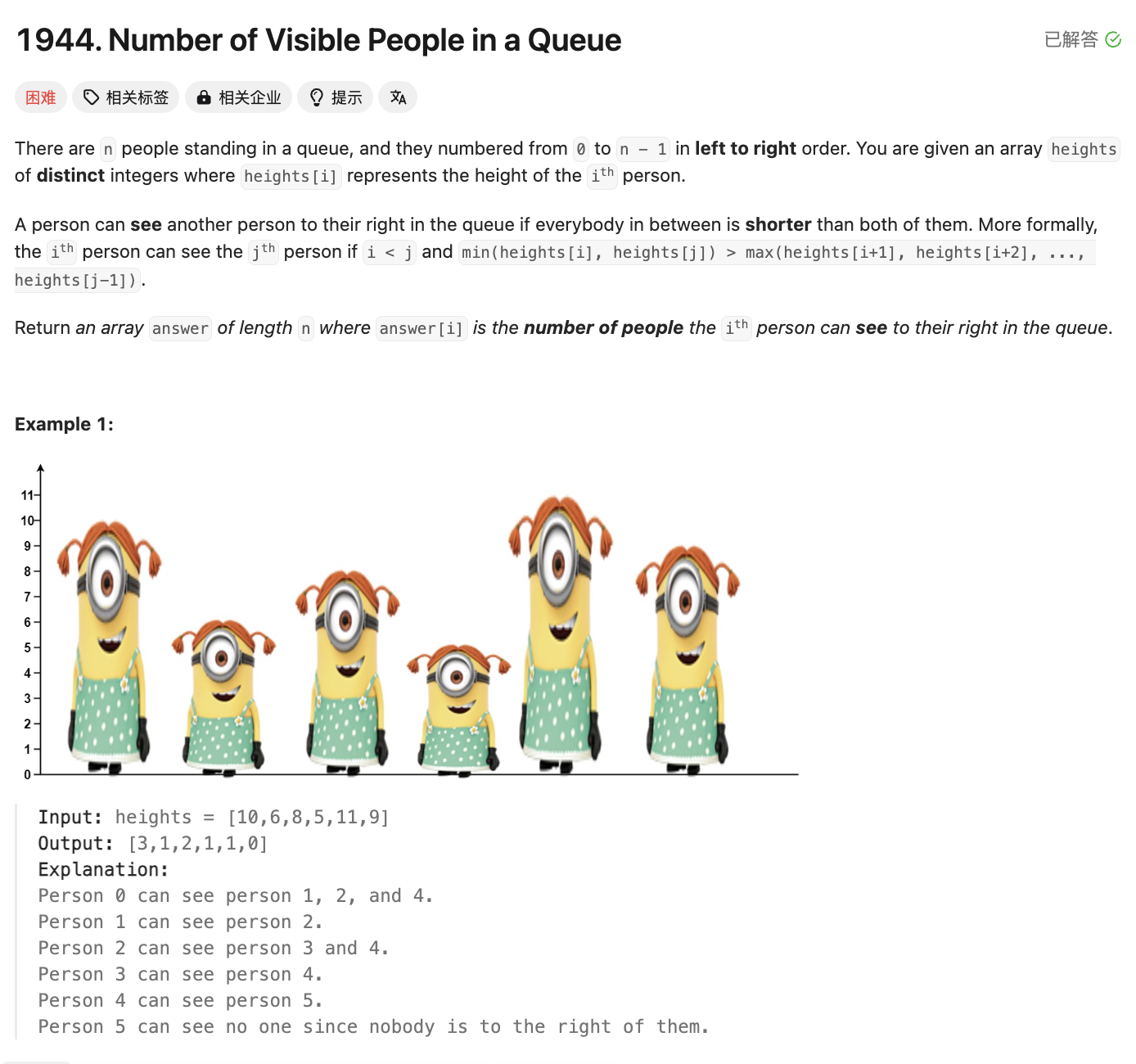
Version 1
单调栈
1
2
3
4
5
6
7
8
9
10
11
12
13
14
15
16
17
| class Solution {
public:
vector<int> canSeePersonsCount(vector<int>& heights) {
int m = heights.size();
stack<int> st;
vector<int> ans = vector(m, 0);
for(int i=m-1;i>=0;--i){
while(!st.empty() && heights[i] > st.top()){
ans[i]++;
st.pop();
}
if(!st.empty()) ans[i]++;
st.push(heights[i]);
}
return ans;
}
};
|

Version 1
最大公约数的计算方法
1
2
3
4
5
6
7
8
9
10
11
12
13
14
15
16
17
18
| class Solution {
public:
int gcb(int x, int y){
if(y == 0) return x;
return gcb(y, x % y);
}
ListNode* insertGreatestCommonDivisors(ListNode* head) {
ListNode *t = head, *tn;
int x, y;
while(t->next) {
x = t->val, y = t->next->val;
tn = t->next;
t->next = new ListNode(gcb(x, y), tn);
t = tn;
}
return head;
}
};
|
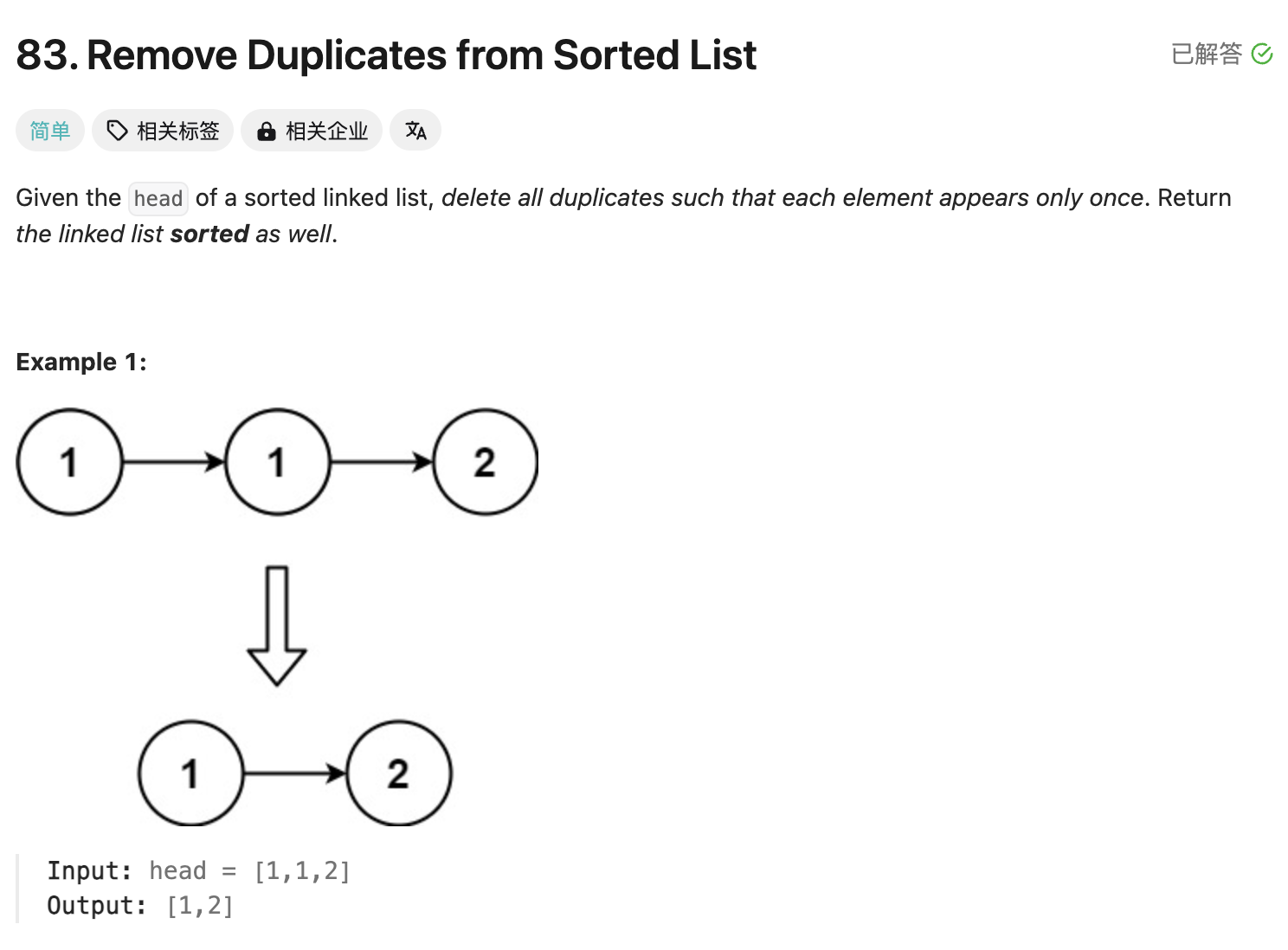
Version 1
1
2
3
4
5
6
7
8
9
10
11
12
13
14
15
16
17
18
| class Solution {
public:
ListNode* deleteDuplicates(ListNode* head) {
if(!head) return head;
vector<bool> m = vector<bool>(201, false);
ListNode *t = head;
m[t->val+100] = true;
while(t->next){
if(m[t->next->val + 100] == true){
t->next = t->next->next;
}else{
m[t->next->val + 100] = true;
t = t->next;
}
}
return head;
}
};
|
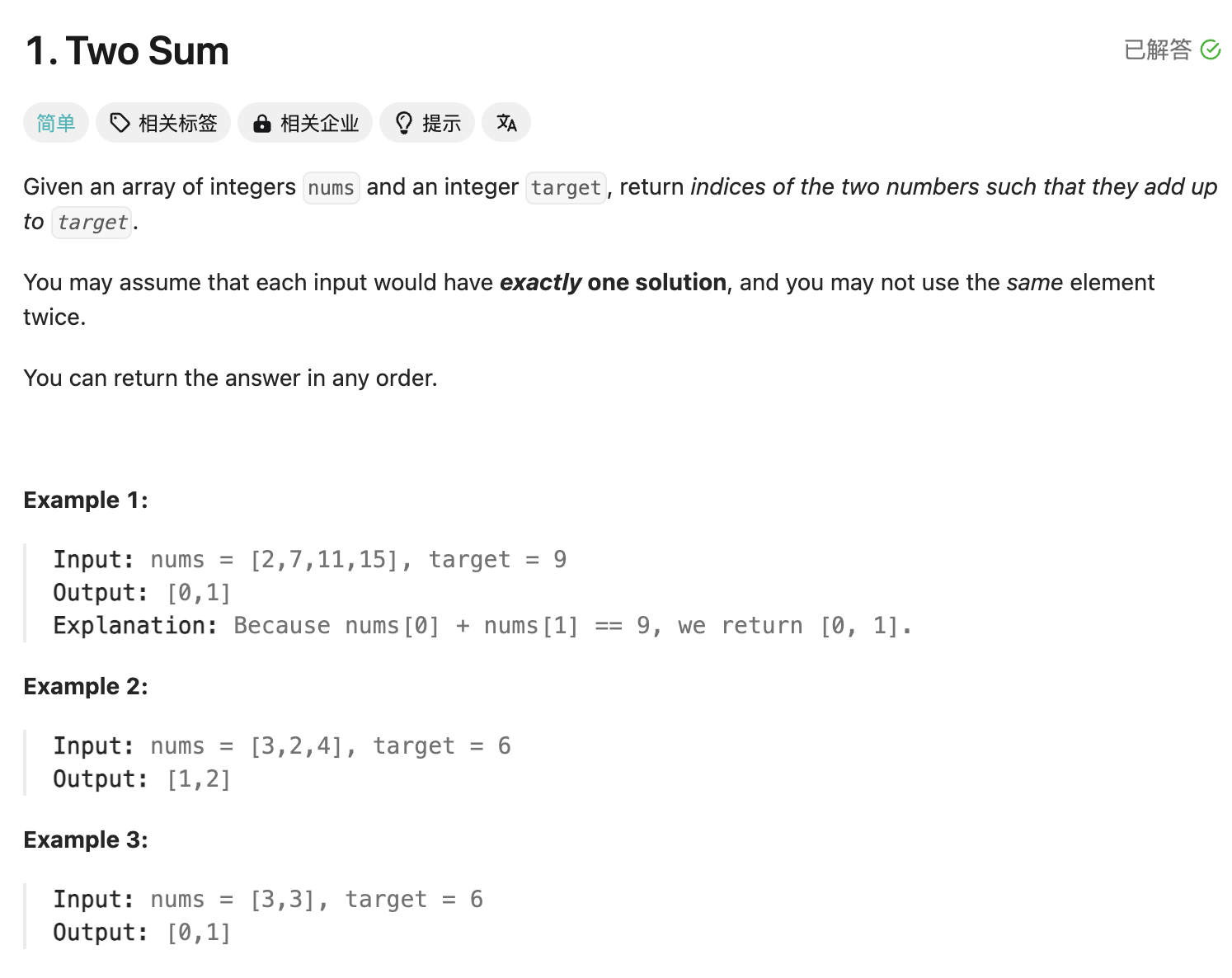
Version 1
暴力
1
2
3
4
5
6
7
8
9
10
11
12
13
14
15
16
| class Solution {
public:
vector<int> twoSum(vector<int>& nums, int target) {
int i, j, n = nums.size();
vector<int> ans = vector<int>(2, 0);
for(i=0;i<n;++i){
for(j=i+1;j<n;++j){
if(nums[i]+nums[j]==target){
ans[0] = i, ans[1] = j;
return ans;
}
}
}
return ans;
}
};
|
Version 2
排序之后,双指针
1
2
3
4
5
6
7
8
9
10
11
12
13
14
15
16
17
18
19
20
21
22
23
24
25
26
27
| class Solution {
public:
vector<int> twoSum(vector<int>& nums, int target) {
int i, j, k, n = nums.size();
vector<int> on = nums;
sort(on.begin(), on.end());
vector<int> ans = vector<int>(2, -1);
i=0, j=n-1;
while(i<j){
if(on[i]+on[j]==target){
for(k=0;k<n;++k){
if(nums[k]==on[i]&&ans[0]<0){
ans[0]=k;
} else if(nums[k]==on[j]){
ans[1]=k;
}
}
break;
} else if(on[i]+on[j]>target) {
--j;
} else {
++i;
}
}
return ans;
}
};
|
Version 3
哈希表
1
2
3
4
5
6
7
8
9
10
11
12
13
14
15
16
17
18
| class Solution {
public:
vector<int> twoSum(vector<int>& nums, int target) {
map<int, int> mp;
int i, n = nums.size();
vector<int> ans = vector<int>(2, -1);
for(i=0;i<n;++i){
if(mp.find(target-nums[i])!=mp.end()){
ans[0]=mp.find(target-nums[i])->second;
ans[1]=i;
break;
} else {
mp.insert(pair(nums[i], i));
}
}
return ans;
}
};
|
升级一下使用unordered_map
1
2
3
4
5
6
7
8
9
10
11
12
13
14
15
16
| class Solution {
public:
vector<int> twoSum(vector<int>& nums, int target) {
unordered_map<int, int> mp;
int i, n = nums.size();
for(i=0;i<n;++i){
auto it = mp.find(target-nums[i]);
if(it!=mp.end()){
return {it->second, i};
} else {
mp.emplace(nums[i], i);
}
}
return {0, 0};
}
};
|
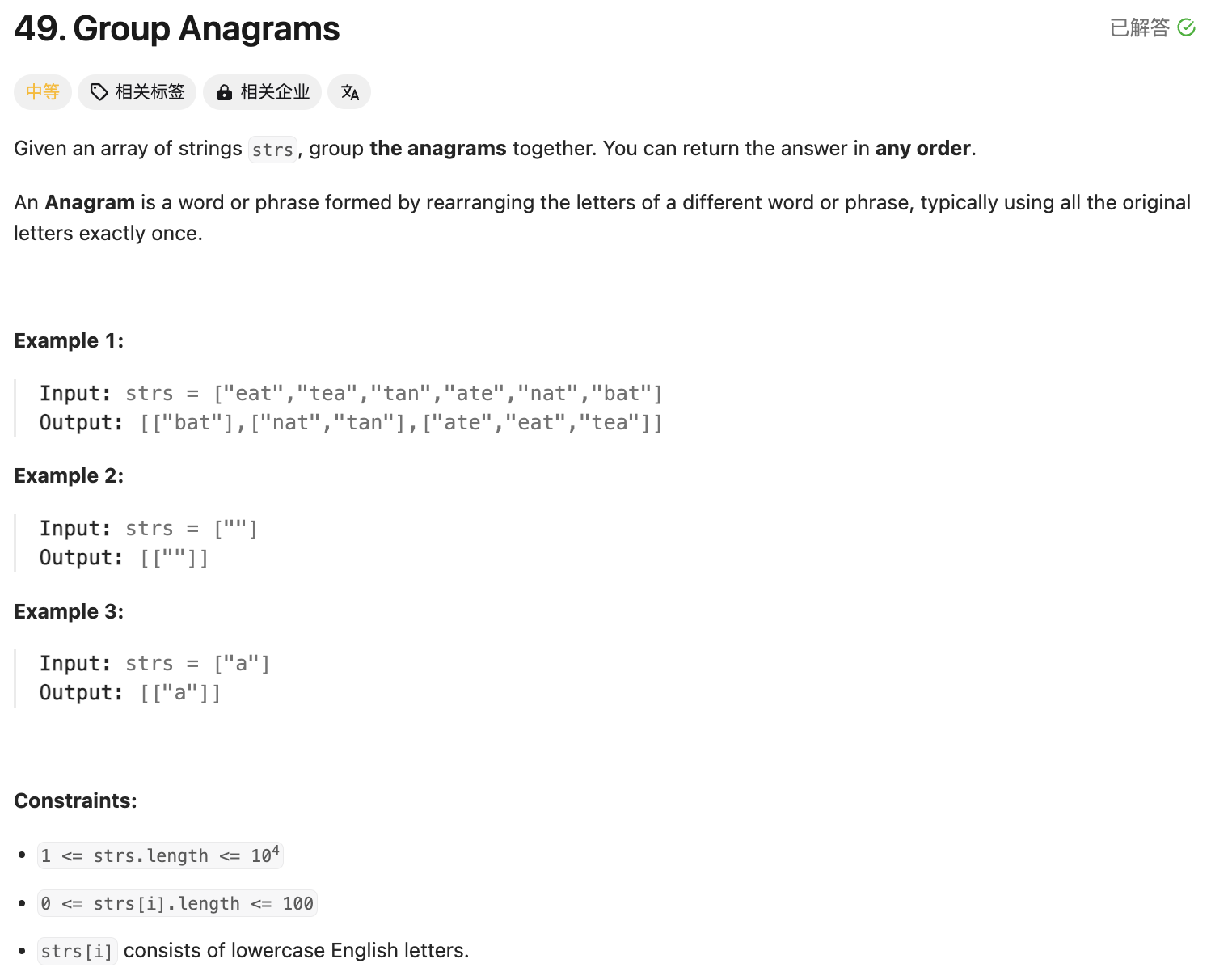
Version 1
暴力
1
2
3
4
5
6
7
8
9
10
11
12
13
14
15
16
17
18
19
20
21
22
23
24
25
26
| class Solution {
public:
vector<vector<string>> groupAnagrams(vector<string>& strs) {
int n = strs.size(), i, j;
map<vector<short>, vector<string>> mp;
for(i=0;i<n;++i){
vector<short> r = vector<short>(26, 0);
for(j=0;j<strs[i].size();++j){
++r[strs[i][j]-'a'];
}
auto t = mp.find(r);
if(t!=mp.end()){
t->second.push_back(strs[i]);
} else{
mp[r] = {strs[i]};
}
}
vector<vector<string>> ans;
for(auto t=mp.begin();t!=mp.end();){
ans.push_back(t->second);
++t;
}
return ans;
}
};
|
Version 2
在暴力的基础上,优化存储空间
1
2
3
4
5
6
7
8
9
10
11
12
13
14
15
16
17
18
19
20
21
22
23
| class Solution {
public:
vector<vector<string>> groupAnagrams(vector<string>& strs) {
int n = strs.size(), i, j;
map<vector<short>, int> mp;
vector<vector<string>> ans;
for(i=0;i<n;++i){
vector<short> r = vector<short>(26, 0);
for(j=0;j<strs[i].size();++j){
++r[strs[i][j]-'a'];
}
auto t = mp.find(r);
if(t!=mp.end()){
ans[t->second].push_back(strs[i]);
} else{
mp[r] = ans.size();
ans.push_back({strs[i]});
}
}
return ans;
}
};
|
Version 3
继续简化存储
1
2
3
4
5
6
7
8
9
10
11
12
13
14
15
16
17
18
19
20
21
22
23
24
25
26
27
28
29
| class Solution {
public:
vector<vector<string>> groupAnagrams(vector<string>& strs) {
int n = strs.size(), i, j;
vector<short> rd = vector<short>(26, 0);
unsigned long long r;
unordered_map<long, int> mp;
vector<vector<string>> ans;
for(i=0;i<n;++i){
r = 0;
rd.assign(26, 0);
for(j=0;j<strs[i].size();++j){
rd[strs[i][j]-'a']++;
}
for(j=0;j<26;++j){
r += rd[j];
r *= 101;
}
auto t = mp.find(r);
if(t!=mp.end()){
ans[t->second].push_back(strs[i]);
} else{
mp[r] = ans.size();
ans.push_back({strs[i]});
}
}
return ans;
}
};
|
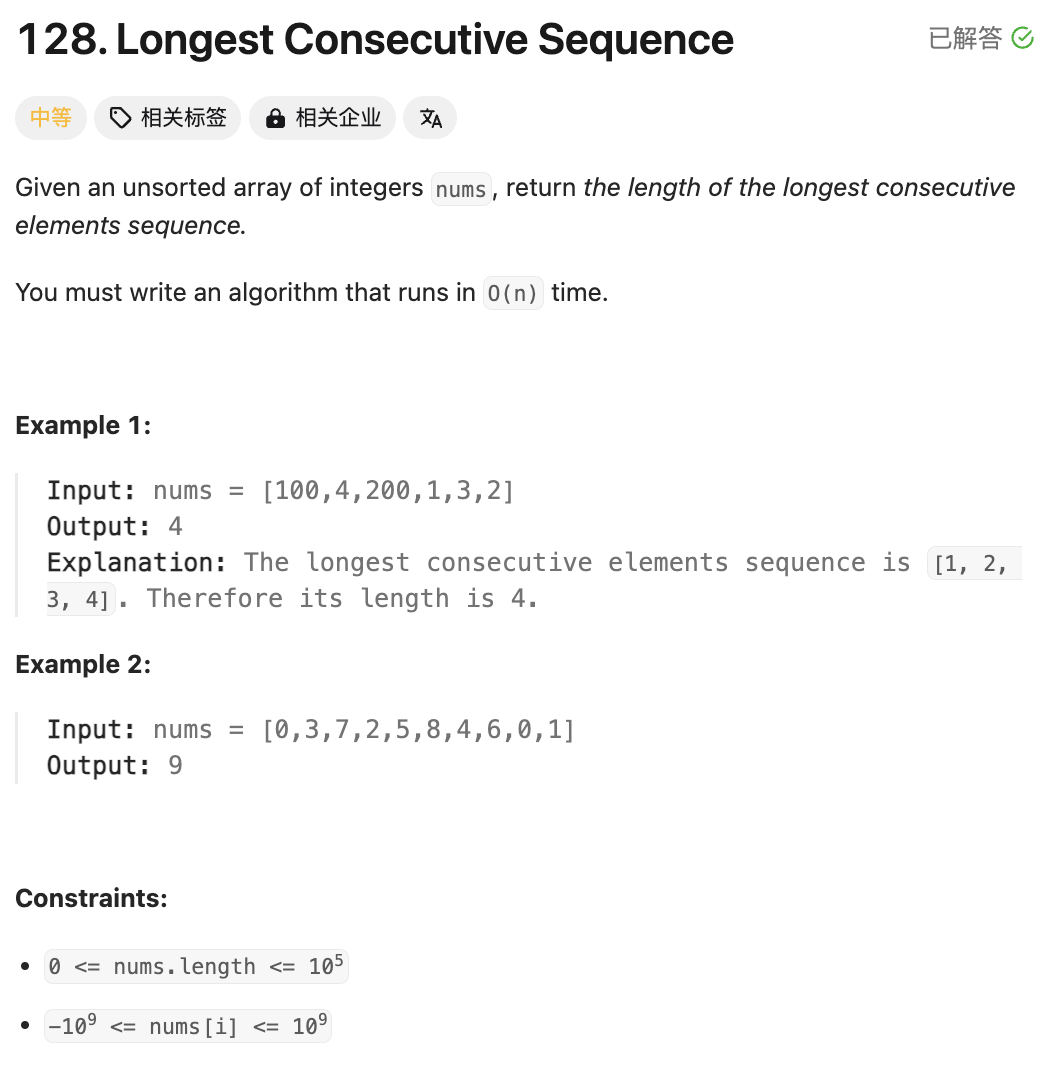
Version1
- 关键点:找到每个序列的起始元素
- unordered_set的应用
1
2
3
4
5
6
7
8
9
10
11
12
13
14
| class Solution {
public:
int longestConsecutive(vector<int>& nums) {
set<int> st(nums.begin(), nums.end());
int ans=0, j, k;
for(int&x:nums){
if(st.find(x-1)==st.end()){
for(j=x+1,k=1;st.find(j)!=st.end();++k,++j);
ans=max(ans, k);
}
}
return ans;
}
};
|
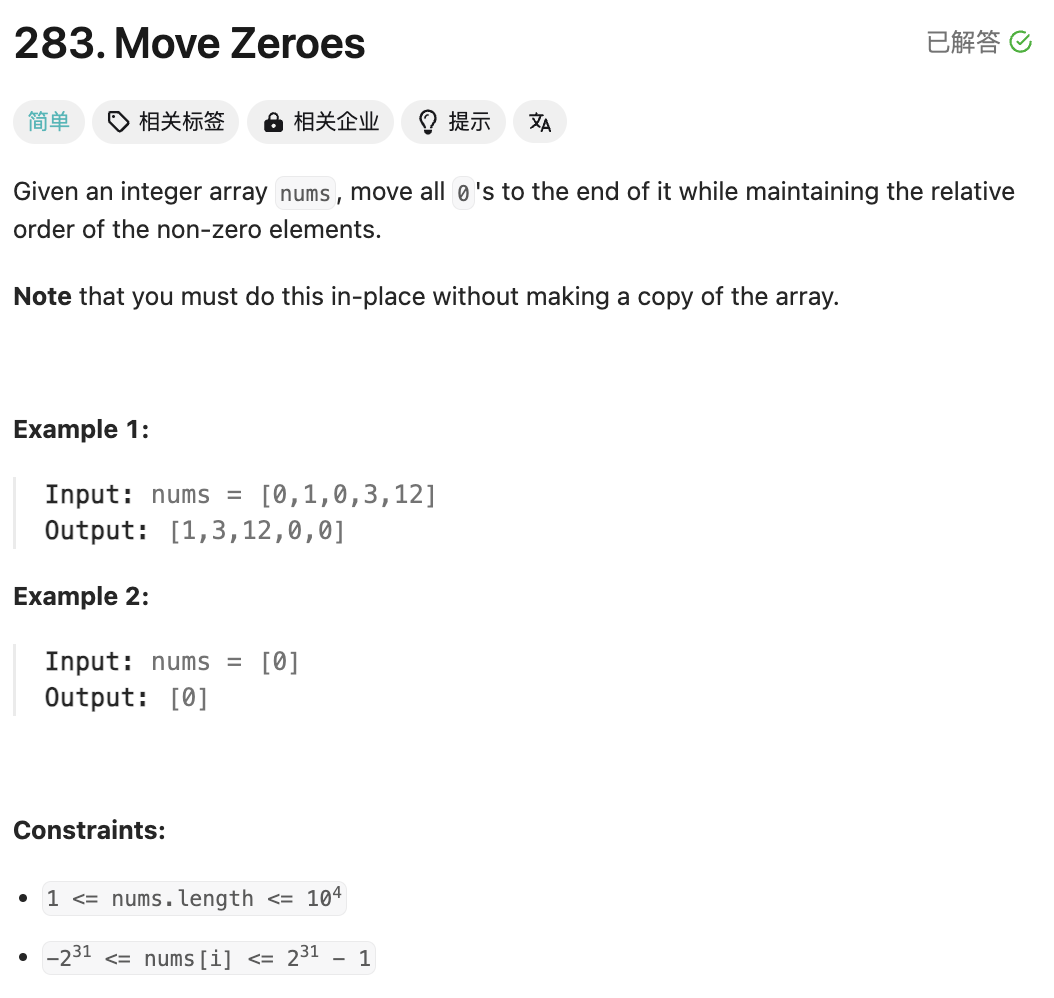
Version 1
1
2
3
4
5
6
7
8
9
10
| class Solution {
public:
void moveZeroes(vector<int>& nums) {
int i, j, n=nums.size();
for(i=0,j=0;j<n;++j)
if(nums[j]!=0)
nums[i++]=nums[j];
while(i<n) nums[i++]=0;
}
};
|
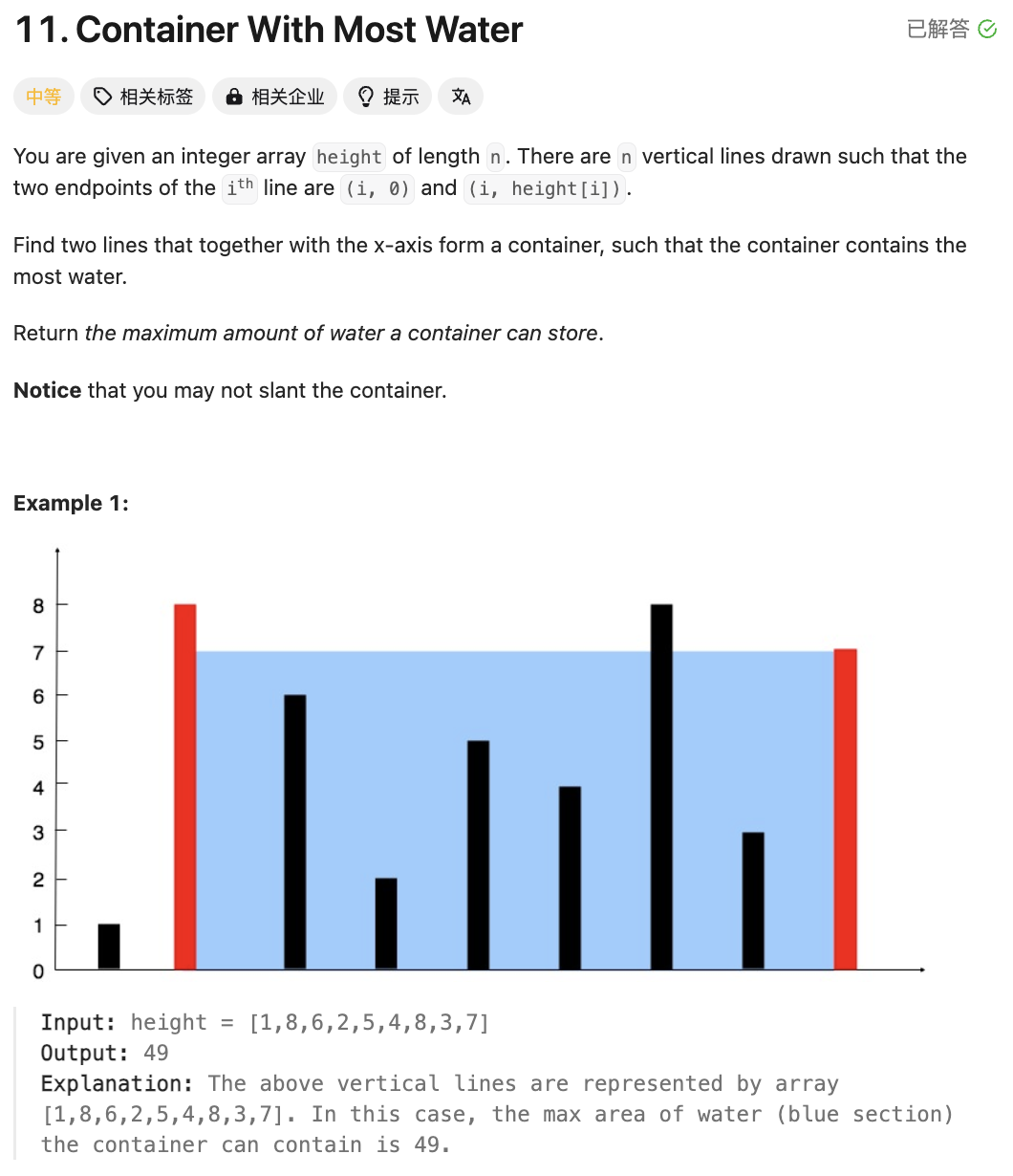
Version 1
1
2
3
4
5
6
7
8
9
10
11
12
| class Solution {
public:
int maxArea(vector<int>& height) {
int i=0, j=height.size()-1, ans=0;
while(i<j){
ans = max(ans, min(height[i], height[j]) * (j-i));
if(height[i]<height[j]) ++i;
else --j;
}
return ans;
}
};
|
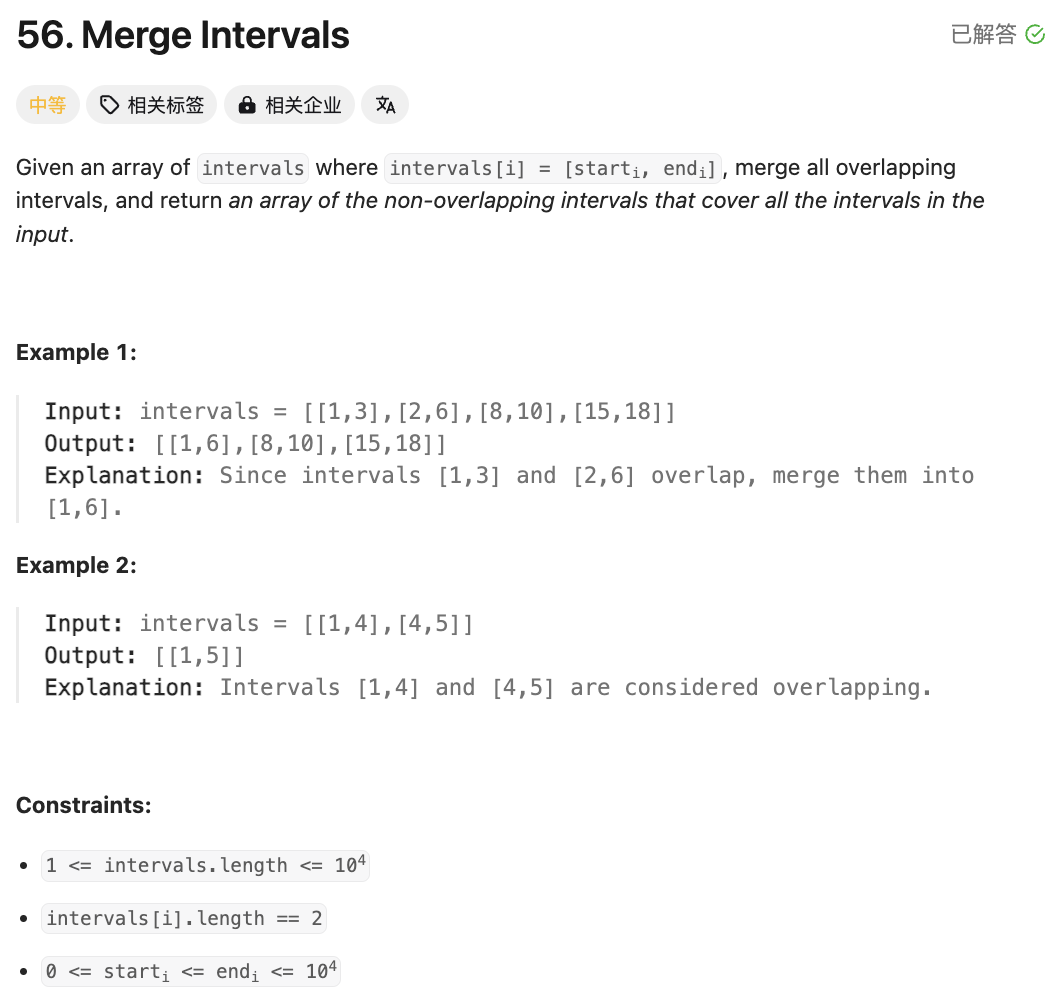
Version 1
暴力
1
2
3
4
5
6
7
8
9
10
11
12
13
14
15
16
17
18
19
20
21
22
23
24
25
26
27
28
29
30
31
32
33
34
35
36
37
38
39
40
| class Solution {
public:
void p(vector<vector<int>>& vec, int n){
cout << " ## "<<endl;
for(int i=0;i<n;++i){
cout<<i<<": "<<vec[i][0]<<" "<<vec[i][1]<<endl;
}
cout << " ## "<<endl;
}
vector<vector<int>> merge(vector<vector<int>>& intervals) {
int i, j, op;
int k = intervals.size();
while(true){
op=0;
for(i=0;i<k;++i){
for(j=0;j<k;){
if(i!=j && i<k && j<k && (
(intervals[i][0]>=intervals[j][0]&&intervals[i][0]<=intervals[j][1])
|| (intervals[i][1]>=intervals[j][0]&&intervals[i][1]<=intervals[j][1])
|| (intervals[j][0]>=intervals[i][0]&&intervals[j][0]<=intervals[i][1])
|| (intervals[j][1]>=intervals[i][0]&&intervals[j][1]<=intervals[i][1])
)
){
intervals[i][0]=min(intervals[i][0], intervals[j][0]);
intervals[i][1]=max(intervals[i][1], intervals[j][1]);
swap(intervals[j], intervals[k-1]);
--k, ++op;
}else{
++j;
}
}
}
if(op==0) break;
}
return vector<vector<int>>(intervals.begin(), intervals.begin() + k);
}
};
|
Version 2
排序之后,逐个排序处理
1
2
3
4
5
6
7
8
9
10
11
12
13
14
15
16
| class Solution {
public:
vector<vector<int>> merge(vector<vector<int>>& intervals) {
sort(intervals.begin(), intervals.end());
int i, j, n=intervals.size();
vector<vector<int>> ans;
for(i=0;i<n;++i){
if(ans.empty()||ans.back()[1]<intervals[i][0]){
ans.push_back(intervals[i]);
}else if(!ans.empty()&&ans.back()[1]>=intervals[i][0]){
ans.back()[1] = max(ans.back()[1], intervals[i][1]);
}
}
return ans;
}
};
|
Version 3
在version2的基础上,优化空间存储
1
2
3
4
5
6
7
8
9
10
11
12
13
14
15
16
17
18
19
20
21
22
23
24
25
26
27
28
29
30
31
32
33
34
35
36
37
38
39
40
41
| class Solution {
public:
vector<vector<int>> merge(vector<vector<int>>& intervals) {
sort(intervals.begin(), intervals.end());
int i, j, n=intervals.size();
for(j=-1,i=0;i<n;++i){
if(j==-1||intervals[j][1]<intervals[i][0]){
intervals[++j] = intervals[i];
}else if(j!=-1&&intervals[j][1]>=intervals[i][0]){
intervals[j][1] = max(intervals[j][1], intervals[i][1]);
}
}
for(;j<n-1;++j) intervals.pop_back();
return intervals;
}
};
class Solution {
public:
vector<vector<int>> merge(vector<vector<int>>& intervals) {
sort(intervals.begin(), intervals.end(), [](vector<int> &a, vector<int> &b){
if(a[0]!=b[0]) return a[0] < b[0];
else {
return a[1] < b[1];
}
});
int i, j, n=intervals.size();
for(j=-1,i=0;i<n;++i){
if(j==-1||intervals[j][1]<intervals[i][0]){
intervals[++j] = intervals[i];
}else if(j!=-1&&intervals[j][1]>=intervals[i][0]){
intervals[j][1] = max(intervals[j][1], intervals[i][1]);
}
}
intervals.resize(j+1);
return intervals;
}
};
|
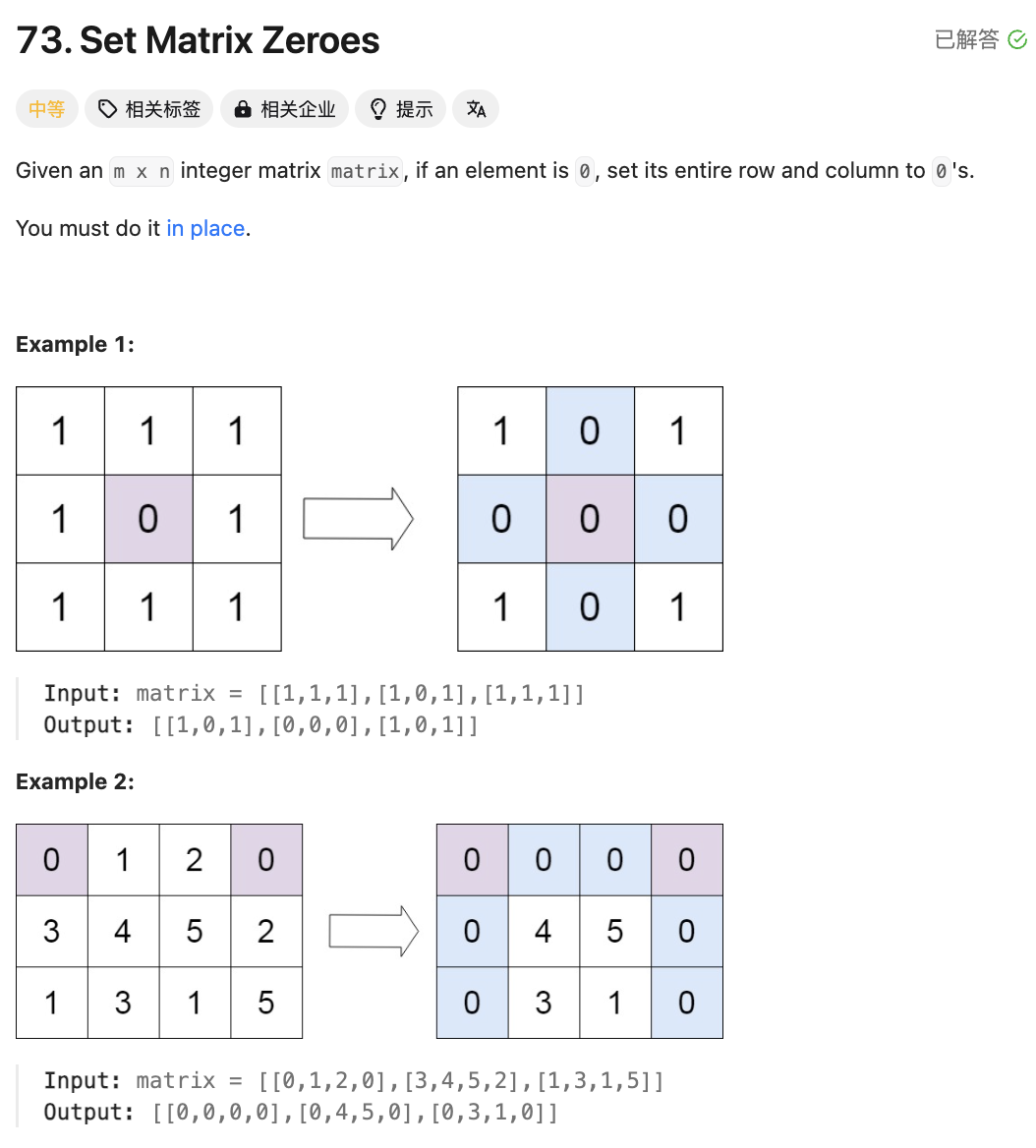
Version 1
用边界进行记忆。
1
2
3
4
5
6
7
8
9
10
11
12
13
14
15
16
17
18
19
20
21
22
23
| class Solution {
public:
void setZeroes(vector<vector<int>>& matrix) {
int i, j, m = matrix.size(), n = matrix[0].size();
bool x = false, y = false;
for(i=0;i<m;++i)if(matrix[i][0]==0) x = true;
for(j=0;j<n;++j)if(matrix[0][j]==0) y = true;
for(i=1;i<m;++i)
for(j=1;j<n;++j)
if(matrix[i][j]==0)
matrix[i][0]=0, matrix[0][j]=0;
for(j=1;j<n;++j)
if(matrix[0][j]==0)
for(i=1;i<m;++i)
matrix[i][j]=0;
for(i=1;i<m;++i)
if(matrix[i][0]==0)
for(j=1;j<n;++j)
matrix[i][j]=0;
if(x) for(i=0;i<m;++i) matrix[i][0]=0;
if(y) for(j=0;j<n;++j) matrix[0][j]=0;
}
};
|
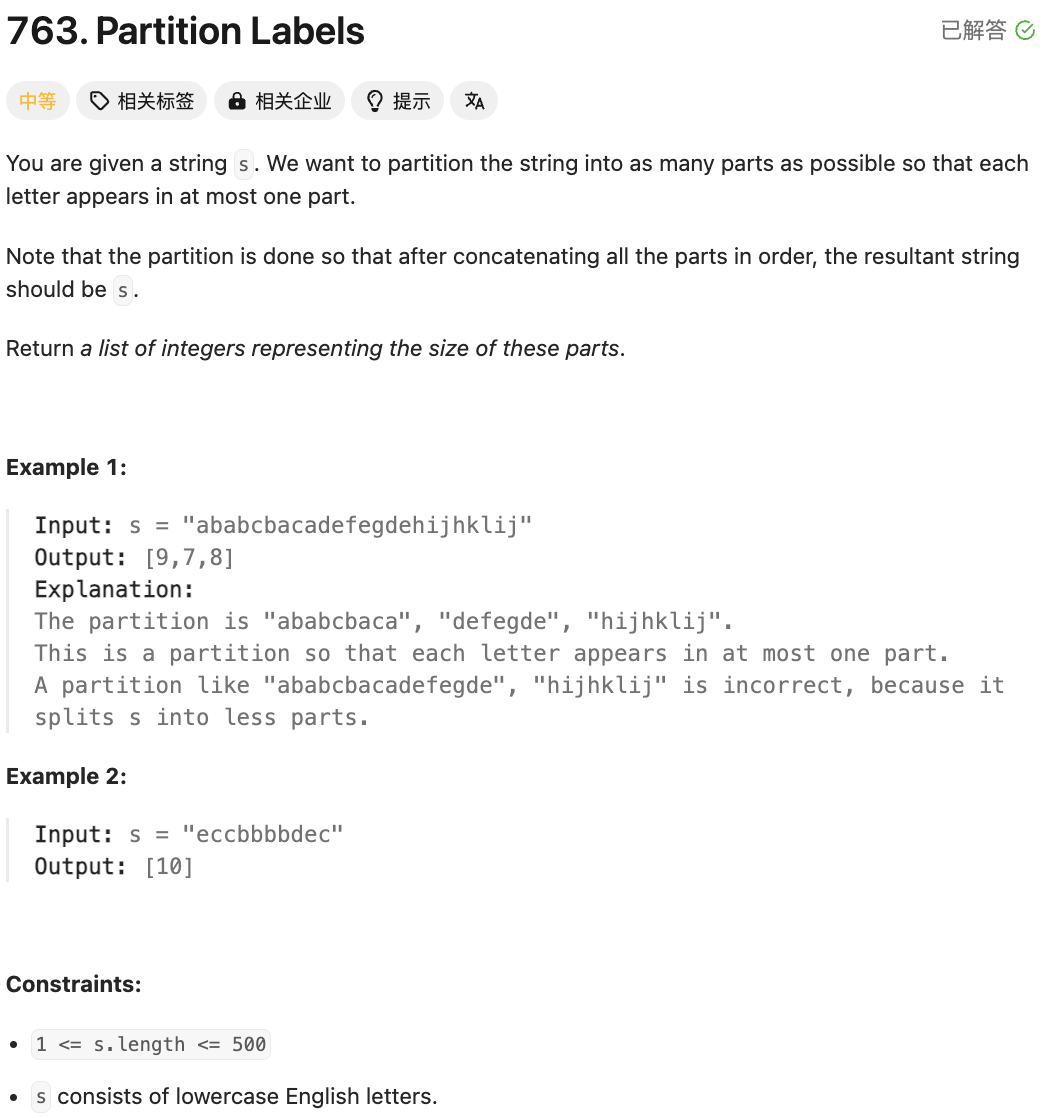
Version 1
记录每个跨度的起始位置,排序之后,如果后一个跨度和前一个不相交的话,生成一段可以截断的段。
1
2
3
4
5
6
7
8
9
10
11
12
13
14
15
16
17
18
19
20
21
22
23
24
25
26
27
28
| class Solution {
public:
vector<int> partitionLabels(string s) {
vector<pair<short, short>> m(26, {1000, -1});
int i, j, n=s.size(), x, y;
for(i=0;i<n;++i){
if(m[s[i]-'a'].first==1000) m[s[i]-'a'].first=i;
m[s[i]-'a'].second=i;
}
for(i=0,j=-1;i<26;++i){
if(m[i].first<1000) m[++j]=m[i];
}
m.resize(j+1);
sort(m.begin(), m.end());
vector<int> ans;
for(i=0,x=-1,y=-1;i<=j;++i){
if(y==-1||m[i].first<y){
if(m[i].second>y) y=m[i].second;
}else{
ans.push_back(y-x);
x=y, y=m[i].second;
}
}
ans.push_back(y-x);
return ans;
}
};
|
Version 2
不断更新最晚可以截断的位置,如果当前坐标和可以截断的坐标一致,就表示可以截断。
1
2
3
4
5
6
7
8
9
10
11
12
13
14
15
16
17
18
| class Solution {
public:
vector<int> partitionLabels(string s) {
vector<short> m(26, -1);
vector<int> ans;
int i, n=s.size(), x=-1, y=-1;
for(i=0;i<n;++i) m[s[i]-'a'] = i;
for(i=0;i<n;++i){
if(m[s[i]-'a']>x)x=m[s[i]-'a'];
if(x==i){
ans.push_back(x-y);
y=x, x=-1;
}
}
return ans;
}
};
|
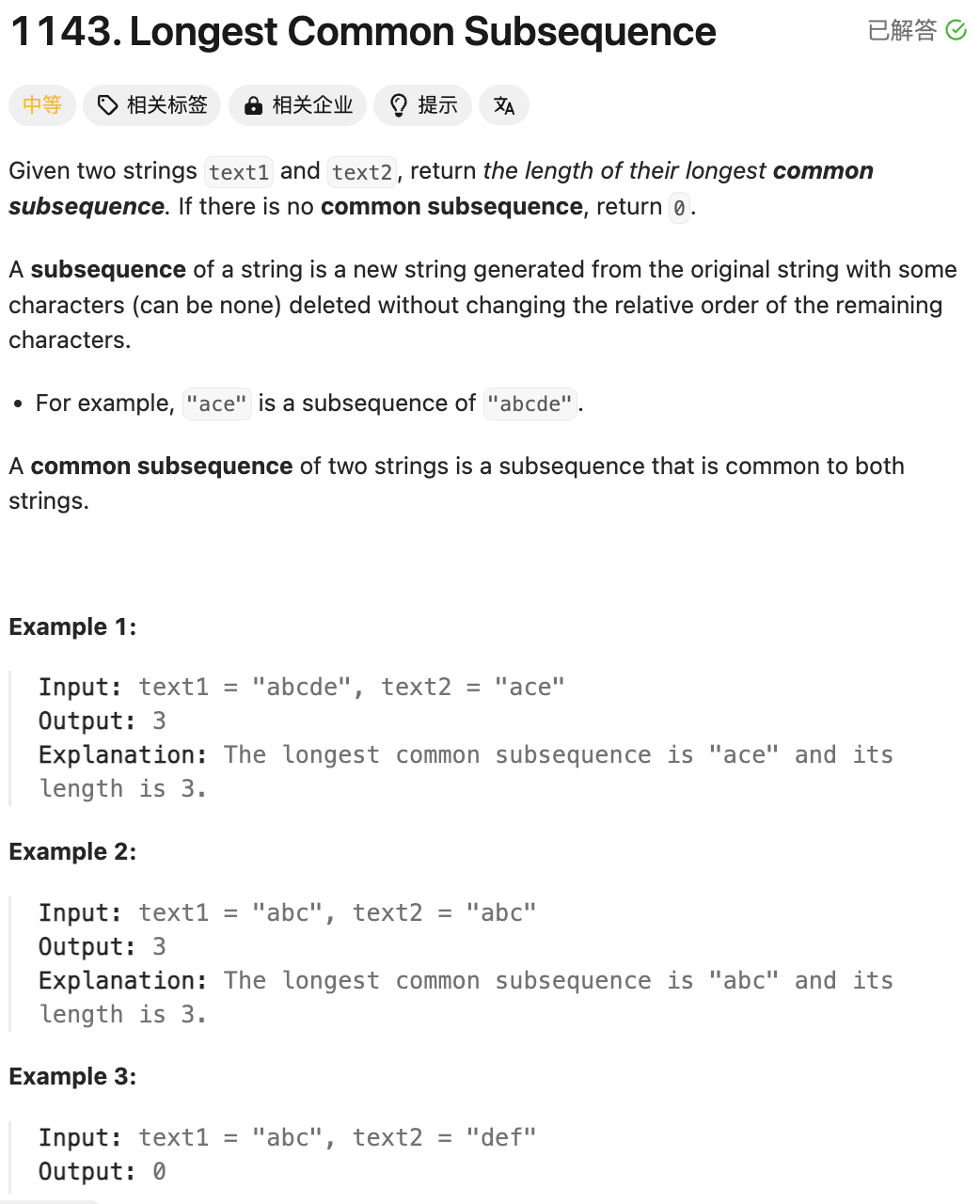
Version 1
动态规划
1
2
3
4
5
6
7
8
9
10
11
12
13
14
15
16
17
18
| class Solution {
public:
int longestCommonSubsequence(string a, string b) {
int i,j,m=a.size(),n=b.size();
vector<int> arr(m, 0), t(m, 0);
for(j=0;j<n;++j){
t = arr;
for(i=0;i<m;++i){
if(a[i]==b[j]){
arr[i]=(i>0?t[i-1]:0)+1;
}else{
arr[i]=max(t[i], i>0?arr[i-1]:0);
}
}
}
return arr[m-1];
}
};
|
Version 2
优化存储
1
2
3
4
5
6
7
8
9
10
11
12
13
14
15
16
17
18
19
| class Solution {
public:
int longestCommonSubsequence(string a, string b) {
int i,j,m=a.size(),n=b.size(), cur;
int dp[2][m];
memset(dp, 0, 2*m*sizeof(int));
for(j=0;j<n;++j){
cur=j%2;
for(i=0;i<m;++i){
if(a[i]==b[j]){
dp[cur][i]=(i>0?dp[1-cur][i-1]:0)+1;
}else{
dp[cur][i]=max(dp[1-cur][i], i>0?dp[cur][i-1]:0);
}
}
}
return dp[cur][m-1];
}
};
|
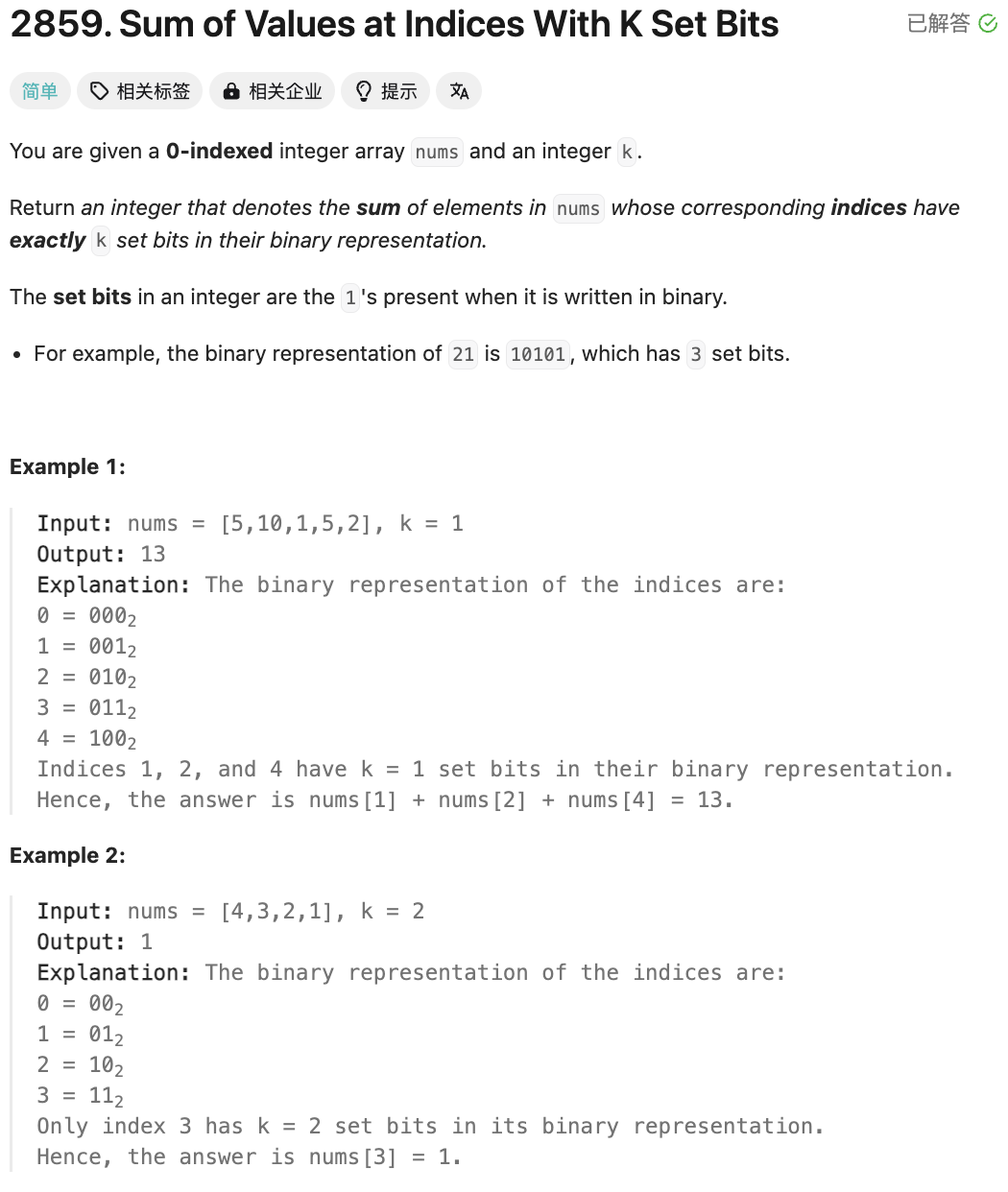
Version 1
1
2
3
4
5
6
7
8
9
10
11
12
| class Solution {
public:
int sumIndicesWithKSetBits(vector<int>& nums, int k) {
int sum=0, i, n=nums.size(), x, y;
for(i=0;i<n;++i){
x=0,y=i;
while(y) x += (y&1), y>>=1;
if(x==k) sum+=nums[i];
}
return sum;
}
};
|
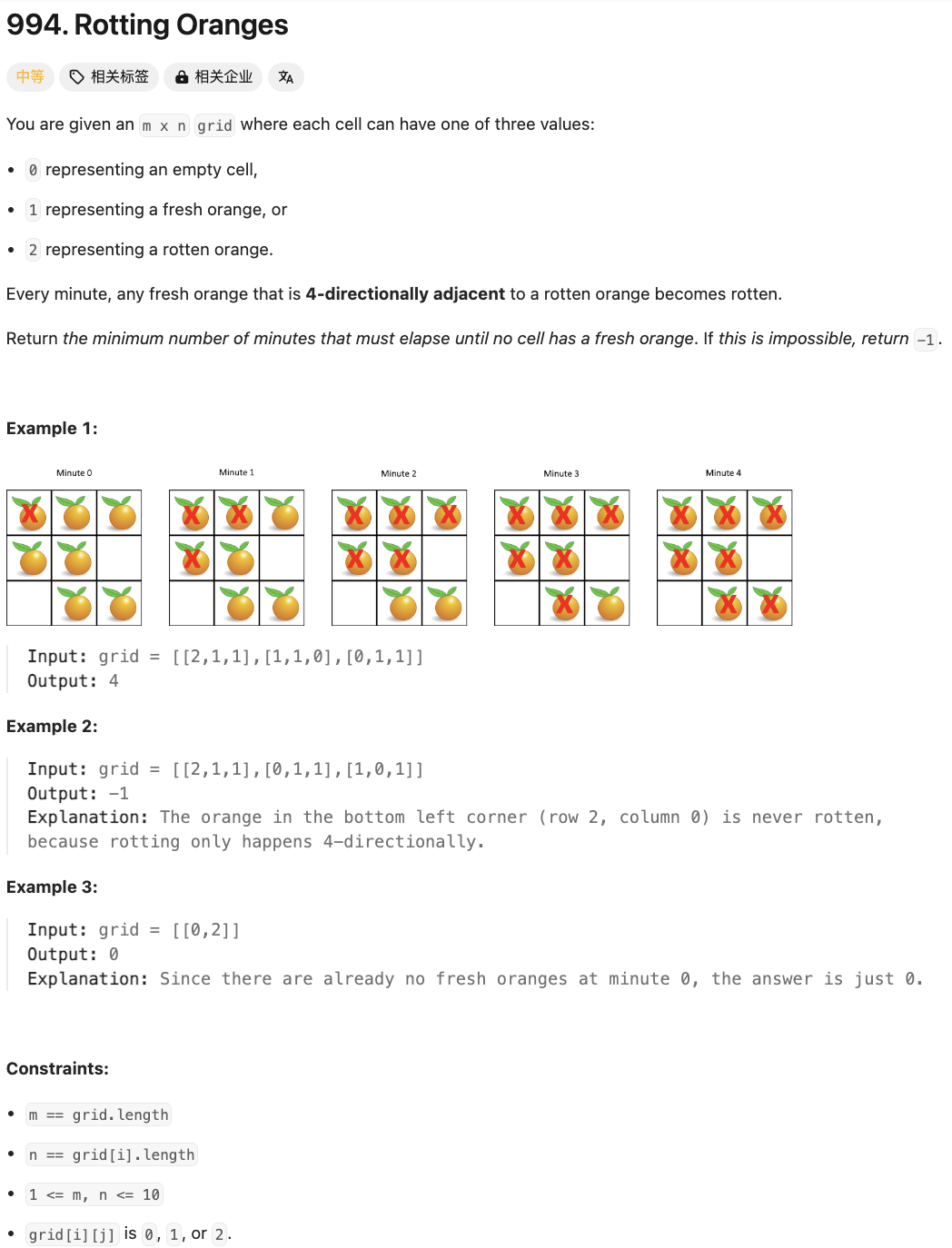
Version 1
暴力
1
2
3
4
5
6
7
8
9
10
11
12
13
14
15
16
17
18
19
20
21
22
23
24
25
26
27
28
29
30
31
32
33
| class Solution {
public:
int orangesRotting(vector<vector<int>>& x) {
int times=0, cn=1, i, j, k, fn=0, m=x.size(), n=x[0].size(), xi, xj;
int dir[4][2]={{-1,0},{1,0},{0,1},{0,-1}};
vector<vector<int>> y=x;
for(i=0;i<m;++i)for(j=0;j<n;++j)if(x[i][j]==1)++fn;
if(fn==0) return 0;
while(cn){
cn=0;
for(i=0;i<m;++i){
for(j=0;j<n;++j){
if(x[i][j]==2){
for(k=0;k<4;++k){
xi=i+dir[k][0], xj=j+dir[k][1];
if(xi<0||xi>=m||xj<0||xj>=n) continue;
if(x[xi][xj]!=1) continue;
++cn;
y[xi][xj]=2;
}
}
}
}
x=y, ++times;
}
for(fn=0,i=0;i<m;++i)for(j=0;j<n;++j)if(x[i][j]==1)++fn;
if(fn==0) return times-1;
else return -1;
}
};
|
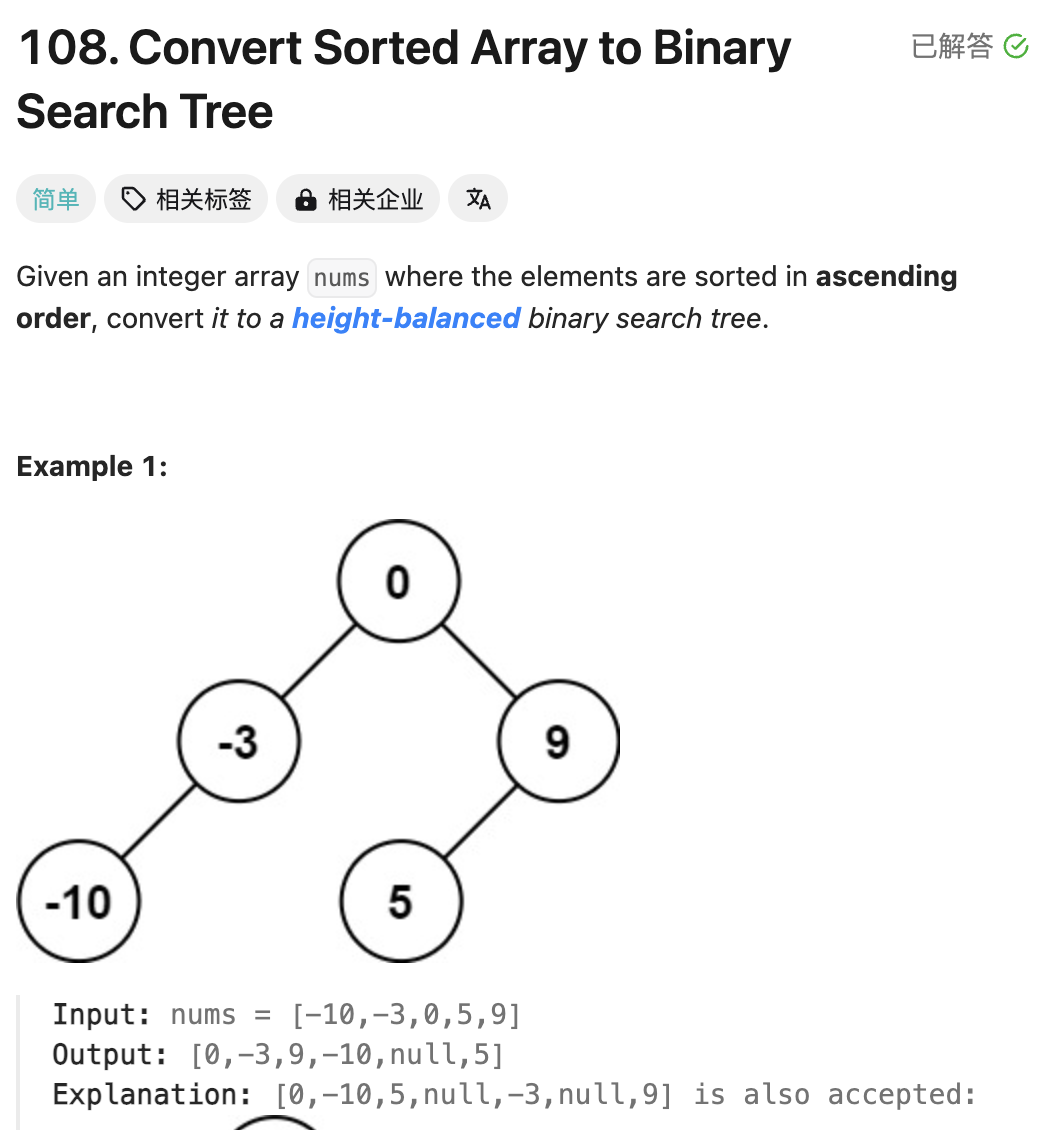
1
2
3
4
5
6
7
8
9
10
11
12
13
14
15
| class Solution {
public:
TreeNode* buildTree(vector<int>& nums, int lft, int rgh) {
if(lft>rgh) return nullptr;
if(lft==rgh) return new TreeNode(nums[lft], nullptr, nullptr);
int center = (lft+rgh)/2;
TreeNode *root = new TreeNode(nums[center], 0, 0);
root->left = buildTree(nums, lft, center-1);
root->right = buildTree(nums, center+1, rgh);
return root;
}
TreeNode* sortedArrayToBST(vector<int>& nums) {
return buildTree(nums, 0, nums.size()-1);
}
};
|















